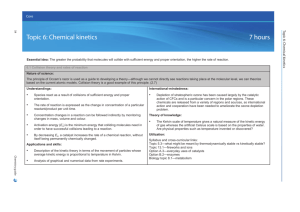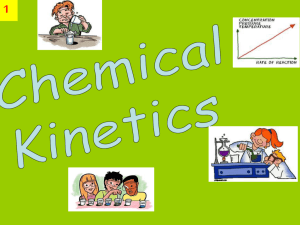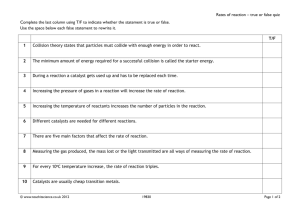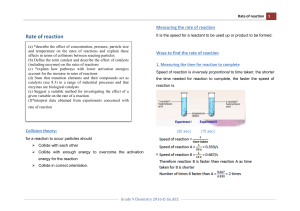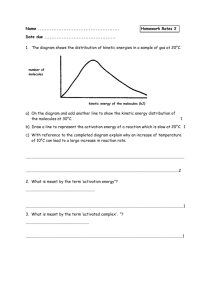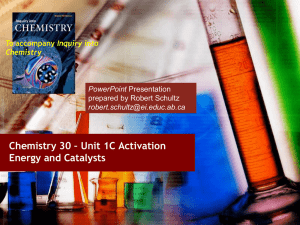Reaction Rates and Equilibrium
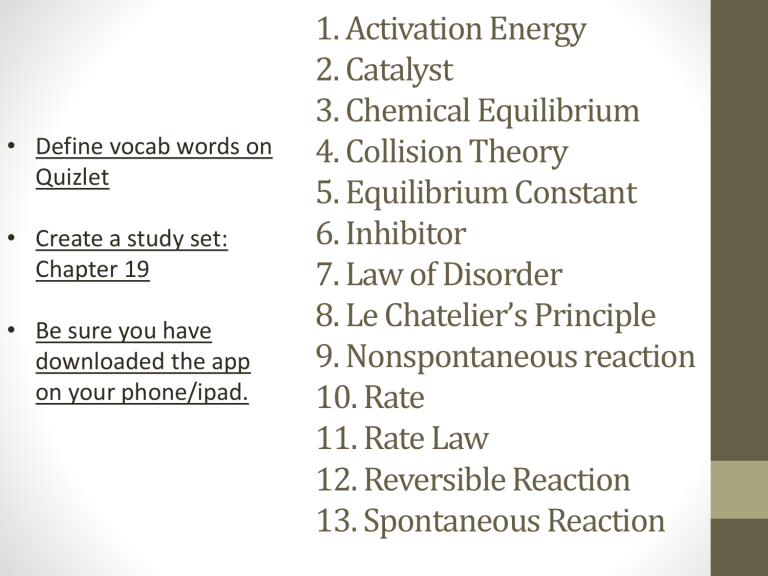
• Define vocab words on
Quizlet
• Create a study set:
Chapter 19
• Be sure you have downloaded the app on your phone/ipad.
1. Activation Energy
2. Catalyst
3. Chemical Equilibrium
4. Collision Theory
5. Equilibrium Constant
6. Inhibitor
7. Law of Disorder
8. Le Chatelier’s Principle
9. Nonspontaneous reaction
10. Rate
11. Rate Law
12. Reversible Reaction
13. Spontaneous Reaction
Reaction Rates and
Equilibrium
Rates of Reaction
Think about it…
• What are some ways the rate of a reaction can be increased?
• What is a Rate??
• A rate tells you how much something changes in a specified amount of time.
• Chemical Kinetics is the study of how fast a chemical reaction occurs
• Examples could be your speed or growth
Reaction Rates
• Some reactions occur very quickly, almost instantaneously
• i.e. striking a match
• Others can occur very, very slowly
• i.e. coal forming from dead organic matter
• Rates of reaction vary greatly and depend on several characteristics.
Collision Theory
• Rates of chemical reactions are related to the properties of atoms, ions, and molecules
• The collision theory states that when these particles react they must come into contact and collide with enough kinetic energy.
• If they do not have enough K.E., they bounce off and no rxn occurs (unsuccessful collision)
Collision Theory
• Its not enough that they collide, they must have enough force (kinetic energy) to “stick” and react
How Much Kinetic Energy??
• The amount of force or Kinetic Energy required is known as the Activation Energy, denoted (E a
).
• This is the minimum amount of energy to have in order for a reaction to take place.
• Without it, the particles bounce off and nothing happens.
• This is essentially just a barrier the particles must cross in order to form products.
Activation Energy,
(E a
)
• As stated, this is the minimum amount of energy needed during a collision for a rxn to occur.
Activation Energy,
(E a
)
(∆G)
Crash Course:
https://www.youtube.com/watch?v=7qOFtL3VEBc&list=PL8dPu uaLjXtPHzzYuWy6fYEaX9mQQ8oGr&index=32
Factors Affecting Reaction Rates
• You can modify the rate of almost any reaction by changing the conditions
• Such conditions can be Temperature, Concentration, and Particle Size.
• You could also add a catalyst… what is a catalyst??
• Think about Collision Theory.
• The question you should ask is: What can I do to INCREASE THE NUMBER OF COLLISIONS??
Temperature
• Usually, raising the temperature will speed up a reaction.
• At higher temperatures, the motion of the particles is __________________.
• With this increase in motion also comes an increase of average _______________, thereby giving the particles enough energy to overcome the Activation Energy (E a
)
Concentration
• The number of reacting particles in a given volume also plays a huge role in the speed.
• By sticking in more particles you increase the concentration, which then increases the number of collisions, which thennnn increases the reaction rate (speed)
Particle Size
• The smaller the sample, the more surface area there is for contact
• The more surface area, the more collisions
• One way to increase the surface area is to dissolve them in solution or crush them up
• Crushing or grinding reactants up will greatly increase the speed of reaction.
Catalysts
• What is a catalyst??
• The catalyst itself is NOT used up or altered in any way in a chemical reaction
Catalyzed Reaction
Because catalysts are not consumed or changed in a reaction, they are not written as reactants OR products.
2H
2(g)
+ O
2(g)
Pt
2H
2
O
(l)
Biological Catalysts
• Catalysts in our bodies are VERY important.
• Many necessary reactions do not occur at body temperature (37⁰C) and we cannot simply jack up the temp… Why not??
• In order to help speed up these needed reactions, we add biological catalysts, or
enzymes.
Enzymes
• Without enzymes, digestion of proteins would take years!!!
• We need to obviously speed this reaction up!
• An inhibitor is a substance that interferes with a catalysts’ job.
• Reactions will slow or even stop when an inhibitor is introduced. They stop the catalyst from doing its job
(which is to speed it all up!)
Questions:
• What is chemical kinetics? What is collision theory?
• What is activation energy and how does it relate to the number of collisions that take place in a chemical reaction?
• What is a catalyst?
• If an inhibitor is added to a chemical reaction, what happens to the rate?
• Does every collision between reacting particles lead to products? Explain.
• When the gas to a stove is turned on, the gas does not burn unless lit by a flame. Once lit, however, the gas burns until turned off. Explain these observations in terms of the effect of temperature on reaction rate.
___H
2
+ ____O
2
_____ H
2
O
___Na + ___H(OH) ___Na(OH) + ___H
2
___HgO ___Hg + ___O
2
___Al + ___Fe 2 O 3
___ Al 2 O 3 + ___ Fe
___C
2
H
5
OH + ___O
2
___H
2
O + ___CO
2
___H
2
+ ___N
2
___NH
3
___NH
4
NO
2
___N
2
+ ___H
2
O
___BaCl
2
+ ___Na
2
(SO
4
) ___NaCl + ___Ba(SO
4
)

